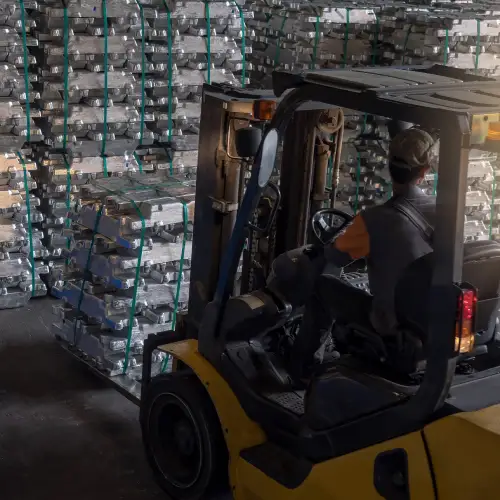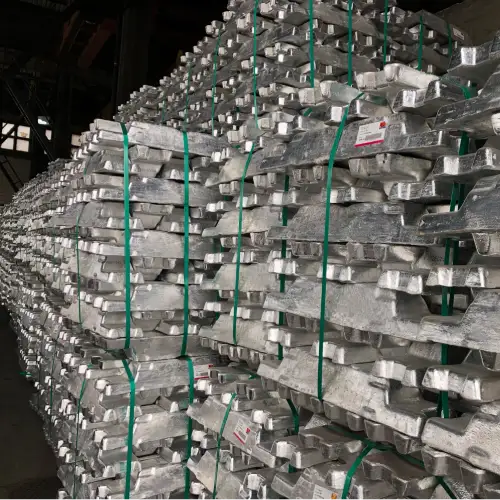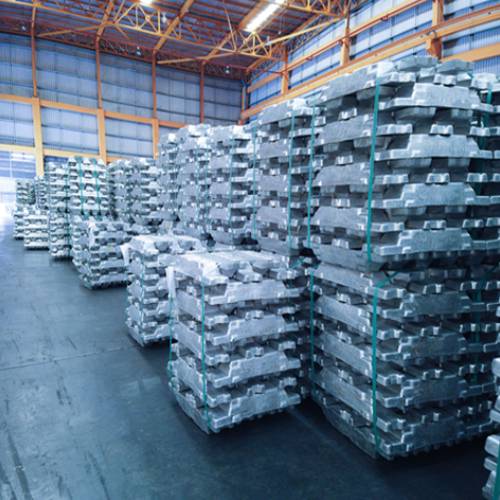OUR PRODUCTS
Secondary Aluminium Ingots
| Grade | Aluminium Ingot Weight |
|---|---|
| 98.5% Min | 5 kg |
| 98% Min | 10 kg |
| 97.5% Min | 20 kg |
| 97% Min | |
| 96% Max |
We Manufacture the Following Grades:
| Grade | Mg | Si | Fe | Cu | Zn | Mn | Others | Al |
|---|---|---|---|---|---|---|---|---|
| 98.5% Min | 0.20% Max | 0.60% Max | 0.40% Max | 0.15% Max | 0.20% Max | 0.15% Max | 0.10% Max | 98.5% Min |
| 98% Min | 0.20% Max | 0.30% Max | 0.40% Max | 0.20% Max | 0.15% Max | 0.50% Max | 0.10% Max | 98% Min |
| 97.5% Min | 0.25% Max | 0.30% Max | 0.60% Max | 0.25% Max | 0.25% Max | 0.80% Max | 0.15% Max | 97.5% Min |
| 97% Min | 0.25% Max | 0.40% Max | 0.60% Max | 0.40% Max | 0.50% Max | 0.80% Max | 0.20% Max | 97% Min |
| 96% Max | 0.30% Max | 1% Max | 1% Max | 0.60% Max | 0.60% Max | 1% Max | 0.30% Max | 96% Min |
Key Features:
 Sustainability:
Sustainability:
Using secondary aluminum ingots minimizes waste and reduces the environmental impact by leveraging recycled materials.
 Versatility:
Versatility:
These ingots can be melted down and alloyed to meet specific industry requirements, providing flexibility in manufacturing.
 Energy Efficiency:
Energy Efficiency:
The production of secondary aluminum ingots requires significantly less energy compared to primary aluminum production.
 Cost-Effective:
Cost-Effective:
Leveraging recycled material often allows for a more economical production process as compared to utilizing virgin materials.
Aluminum secondary ingots, derived from recycled aluminum scrap, are pivotal in numerous industries due to their cost-effectiveness, sustainability, and capability to be utilized in diverse alloy combinations. The process to create these ingots involves collecting and melting scrap aluminum, refining it to remove impurities, and then casting it into ingot shapes for reuse.
This approach not only supports the circular economy but also requires less energy compared to the production of primary aluminum from bauxite ore. By employing secondary aluminum ingots, industries can ensure effective material utilization without compromising quality and material properties. We use primary aluminum (remelt ingot or liquid metal) and scrap to produce ingot for wrought aluminum production. We use a mix of scrap types in order to produce ingot for wrought metal at lowest possible cost.
Applications for Aluminum Ingots:
→ Deoxidation In steel industry :
Process: Aluminum is used as a deoxidizer in steel manufacturing. When aluminum is added to molten steel, it reacts with oxygen to form aluminum oxide, which helps in minimizing the oxygen content in the steel.
Benefits: This process of deoxidation improves the steel’s structural integrity by preventing the formation of unwanted gas pores and improving its toughness and durability.
Forms: Aluminum secondary ingots can be melted and introduced into the steelmaking process for deoxidation purposes.
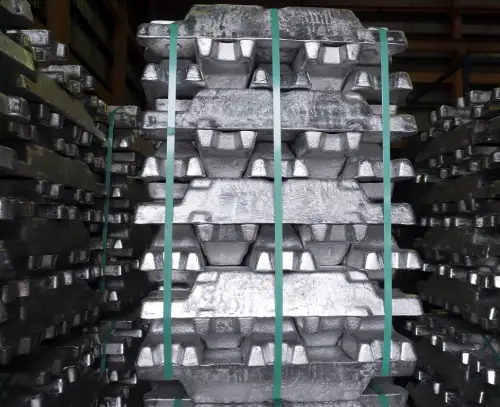
→ Automobile Industry:
Secondary aluminum is widely utilized in the automotive industry to produce components like engine parts, panels, and wheels due to its lightweight and durability.
→ Packaging:
In the packaging industry, recycled aluminum is employed to create cans, foils, and other packaging materials, ensuring sustainability and recyclability.
→ Construction:
Aluminum ingots can be utilized in various construction applications including window frames, panels, and roofing materials owing to its corrosion resistance and strength.
→ Aerospace:
Given the lightweight and high-strength properties, secondary aluminum is used in the manufacturing of various aerospace components.
→ Electrical:
Due to its excellent electrical conductivity, secondary aluminum finds applications in wiring and electrical components manufacturing.
→ Consumer Goods:
Utilized in manufacturing household items, gadgets, and appliances, thanks to its malleability and resistance to corrosion.
Production Process
Collection
Sorting and Cleaning
Melting
Refining
Casting
Connect with us
to explore various options
on recycled aluminium
Storage and Handling
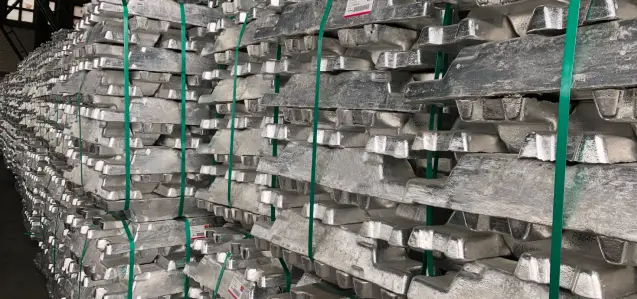
Aluminum secondary ingots should be stored in a clean, dry environment to prevent contamination and corrosion. While handling, adequate safety gear including gloves, safety goggles, and protective clothing should be worn to mitigate the risk of injuries related to handling heavy materials. Additionally, ensuring the ingots are stacked and stored securely minimizes risks related to material displacement or accidental falls.
Conclusion:
Utilizing aluminum secondary ingots is a pragmatic approach toward sustainable development, encouraging the recycling and efficient use of materials across various industries. Considering the resource and energy intensity associated with primary aluminum production, secondary aluminum stands out as an economically and environmentally viable alternative, ensuring the demands of various industries are met while facilitating the judicious use of resources.


